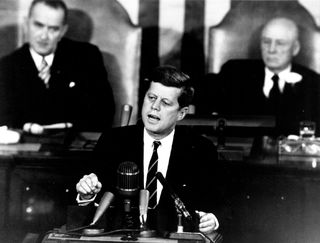If you're wondering why humanity hasn't been to the moon in five decades, consider the circumstances that got us there in the first place.
Sixty years ago today (May 25), President John F. Kennedy announced before a joint session of Congress that the United States planned to put an American on the lunar surface before the 1960s were through.
It was an incredibly audacious goal. On May 25, 1961, the U.S. had not even launched an astronaut to Earth orbit yet, and the nation's first human spaceflight, the 15-minute suborbital jaunt of Alan Shepard, had occurred just three weeks before. The Space Age itself was less than four years old when Kennedy gave his historic moon speech, and NASA had not yet celebrated its third birthday.
Related: NASA's 17 Apollo moon missions in pictures

But speed was of the essence to Kennedy and his advisers. They wanted the U.S. to one-up its Cold War rival, the Soviet Union, which had notched the first two big wins of the space race — the launch of the first satellite, Sputnik 1, in October 1957, and the first human spaceflight, the orbital mission of Yuri Gagarin in April 1961.
And it wasn't just about pride and politics. The project that became Apollo was also viewed as a national security priority, a way to showcase the United States' technological prowess and convince unaligned nations to cast their lots with the capitalist superpower rather than the communist one.
So the U.S. poured money into Apollo throughout the 1960s — a total of about $25 billion, which is well over $100 billion in today's dollars. In both 1965 and 1966, NASA received more than 4.3% of the entire federal budget, compared to about 0.5% today.
Get the Space.com Newsletter
Breaking space news, the latest updates on rocket launches, skywatching events and more!
"Only the construction of the Panama Canal in modern peacetime and the Manhattan Project in war were comparable in scope" to Apollo, the NASA History Office wrote.
The effort and expenditure paid off, of course. In July 1969, the Apollo 11 mission landed Neil Armstrong and Buzz Aldrin on the moon and returned them — and Michael Collins, who had remained in lunar orbit while his crewmates explored the surface — safely to Earth.
NASA landed five more missions on the moon, the last of them, Apollo 17, touching down in December 1972. Then, with the moon race convincingly won, President Richard Nixon refocused NASA's human spaceflight program on developing the Earth-orbiting space shuttle, and Apollo began receding into the pages of history.
For decades afterward, there just wasn't a strong enough incentive — national security, political, economic or otherwise — to convince any nation or private entity to undertake the mammoth effort required to get people back to the moon. But that situation changed recently.
In December 2017, President Donald Trump issued Space Policy Directive-1, which instructed NASA to work on getting astronauts back to the moon and then on to Mars. And in March 2019, the administration told the agency to make the next lunar landing happen by 2024.
NASA has developed a program called Artemis to fulfill these goals, which President Joe Biden has said he'll keep in place (though the 2024 deadline is expected to be relaxed). NASA isn't going it alone, however; it's collaborating with private industry and international partners to make the next moonshot happen.
Like the first moonshot, this next one might get boosted by some space-race momentum. When he announced the 2024 landing goal, for example, then-Vice President Mike Pence invoked a new off-Earth competition with China and Russia. And new NASA chief Bill Nelson struck a similar chord just last week.
China is "going to be landing humans on the moon," Nelson said on May 19 during his first congressional hearing as NASA administrator. "That should tell us something about our need to get off our duff and get our human landing system going vigorously."
Mike Wall is the author of "Out There" (Grand Central Publishing, 2018; illustrated by Karl Tate), a book about the search for alien life. Follow him on Twitter @michaeldwall. Follow us on Twitter @Spacedotcom or Facebook.
Join our Space Forums to keep talking space on the latest missions, night sky and more! And if you have a news tip, correction or comment, let us know at: community@space.com.

Michael Wall is a Senior Space Writer with Space.com and joined the team in 2010. He primarily covers exoplanets, spaceflight and military space, but has been known to dabble in the space art beat. His book about the search for alien life, "Out There," was published on Nov. 13, 2018. Before becoming a science writer, Michael worked as a herpetologist and wildlife biologist. He has a Ph.D. in evolutionary biology from the University of Sydney, Australia, a bachelor's degree from the University of Arizona, and a graduate certificate in science writing from the University of California, Santa Cruz. To find out what his latest project is, you can follow Michael on Twitter.
